| Pages:
1
2 |
Pompano
Elite Nomad
     
Posts: 8194
Registered: 11-14-2004
Location: Bay of Conception and Up North
Member Is Offline
Mood: Optimistic
|
|
Is There a Herpetologist in the House?
How often have you heard someone call out, "Is there a herpetologist in the house?!"
Well, I did once - and two answered.
It was a HOT summer in 1988 at Coyote Bay, Bay of Conception. I had 2 guests..each one a herpetologist. One from San Diego and the other from Salt
Lake City. Where did I meet these two interesting fellows? At the Serinadad Pig Roast, naturally. That's where you met everybody back in those
days.
One of them, Ron Gonzalez, became an especially good friend and returned later that summer (in REALLY HOT August) to renew his search for the
Santa Rosalia rat snake...a prized and elusive specimen that he hoped to capture alive. Hopefully a female with eggs. He had a special
permit to do so for the San Diego Zoo and reptile house.
Here is an account of that visit.
The Sat. Rosalia Rat Snake
Classified in 1899 by a certain researcher named Mocquard. this secretive snake is found mostly at night. It was placed in its own genus based on
immunological data done in 1988. It is also known as the Baja Rat snake and the Santa Rosalia Rat snake. They can be found in extreme southern
California and southward, along the peninsular ranges to the cape of Baja California. Few have been also found on miscellaneous islands in the Sea of
Cortez. They are usually no higher than 300m above sea level.

This map shows the distribution of the somewhat rare rat snake.
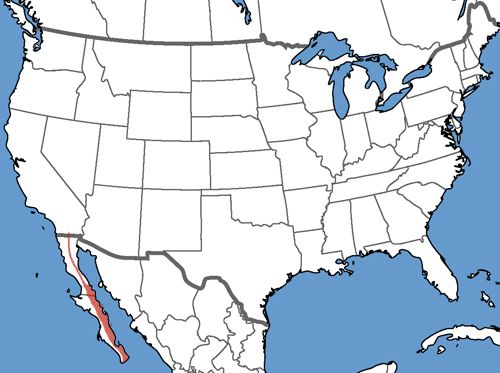
I went out with him on some of his hunts. He said his most productive method was at night, keeping an eye on the optimum temperature from a wrist
gauge he wore, and then go out driving and spotting from the highway or trail. We did just that a few times and sure enough, you'd be amazed at what
we saw crawling on the ground. My open air dune buggy worked perfectly for this snake search while covering a lot of ground.

Fortunately, Ron did acquire a rat snake on this trip, and also managed a few other 'special finds'. Somehow I've lost a series of photos in a
Photobucket shuffle of the many rattlesnakes we found, plus a small constrictor-a boa- found in my driveway, a chuckwalla
in my backyard rockpile, and a few other Baja critters. (Sure wish Photobucket had not changed thier format..caused a lot of grief.) We had three
different types of rattlesnakes in slotted tubes inside my patio beer fridge. They were: Red diamond, lower californian, and speckled rattlers.
Made things a little nervous when going for another cold beer. I made sure Ron had an accurate count on how many rattlers he had put inside the
reefer and that when he left he had exactly the same number!
Snakes, like nomads, know Baja is a great place to be and they certainly have no reason to leave. With these serpents still roaming the land, they are
bound to cross paths with us at certain times. Luckily in most cases, an actual snake bite almost never results in serious harm or death. In fact,
just in the United States alone, over 45,000 people are bit each year. Only 8,000 of those bites are poisonous and only 9 to 15 of those cause death.
My caretaker, Benicio, once suffered a rattlesnake bite on his forearm, and although it took a hospital visit and some healing time he came through,
but got some scars out of the event. Despite the low chance of ever being bit or dying from a bite, the thought does strike fear in the hearts of
even the toughest traveler or Baja resident. It is lucky for us humans that the old adage - 'They're more afraid us than we are of them' -
proves to be true.
You may have heard it all before, but here's some general tips on snakebites:
If you are unfortunate enough to get bit, don't panic. Staying physically and mentally calm will keep the cardiovascular system from speeding up. Try
to remember distinctive markings or be able to identify the type of snake. Look at the bite mark to help determine if it may be venomous or not. If it
is non-poisonous, there will be no fang punctures, only small shallow marks. If it is a venomous bite, you may see one or two large punctures with
smaller teeth marks also. Let the bite bleed out for 20 to 30 seconds before covering. Wash with betadine or soap and water when you can. Apply
pressure and keep the bite close to heart level. You want to apply adequate pressure but do not cut off blood supply to the area either.
Do not cut open the area around the bite, as this has been shown to damage surrounding tissue making the bite worse. Do not suck out the
venom either. This is no longer seen as helpful. Remove any items that may constrict the body when inevitable swelling occurs, such as rings,
bracelets and shoes. Do not use ice packs on the bite. Calmly seek medical attention as soon as possible in order to receive potentially
life-saving antivenin treatments.
The best way to avoid ever being in a situation where you are in need of treatment is to respect and be aware of your surroundings in the natural
world. If you are careful to not disturb or get too close to a snake, it too will avoid you at all cost.
On one special evening Ron gave a great talk for some friends and neighbors next to my patio beer fridge about some captures we had made the night
before...and I videoed the event. Here are some my own 'captures' made from those old videos. Please excuse the poor quality of some of the
'captured' photos. Featured persons in the video are Ron and an amigo from Mulege...Pepe. It was a fun and very instrucitve evening. We all learned
volumes about herpetology.
Ron gives us an impromptu seminar on his specialty...herpetology. Like I said, it was a very hot night on my patio, but thank God
we're next to that beer fridge!

First, Ron has a couple of small snakes in his carry bag for a 'show and tell'.

Gently, he brings out a sand or night snake, which he says is very common in our area, but which we seldom see one.
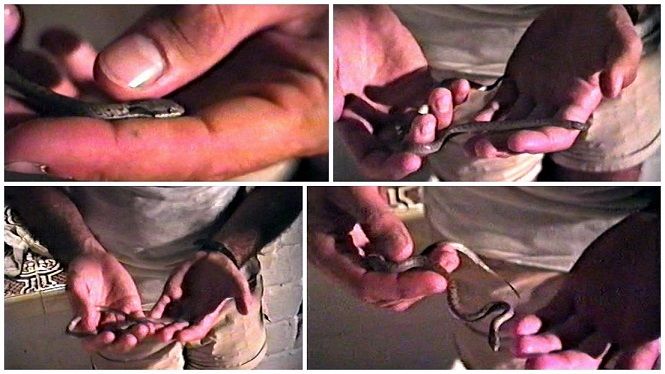
Mi Mulege amigo, Pepe, enjoys the discussion and offers to hold the sand/night snake.
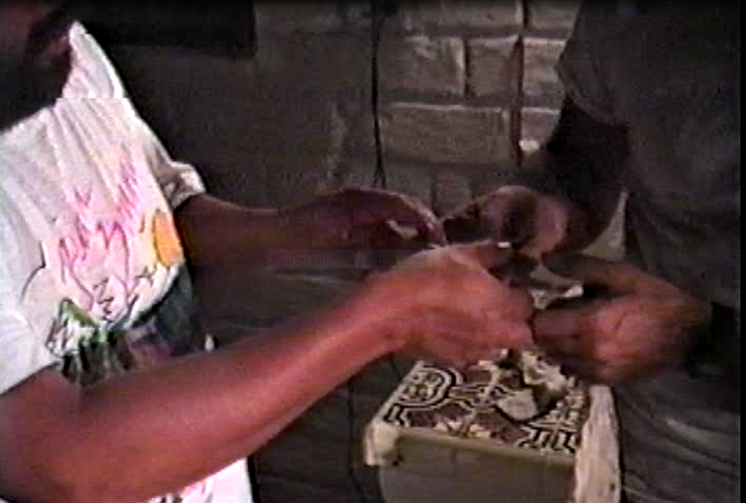
Getting into the swing of things like a pro, Pepe becomes comfortable handling the snake. He holds it towards my video camera and it seems to be
fascinated by the blinking red light. (lower right pic)

Then a mature banded sand snake.
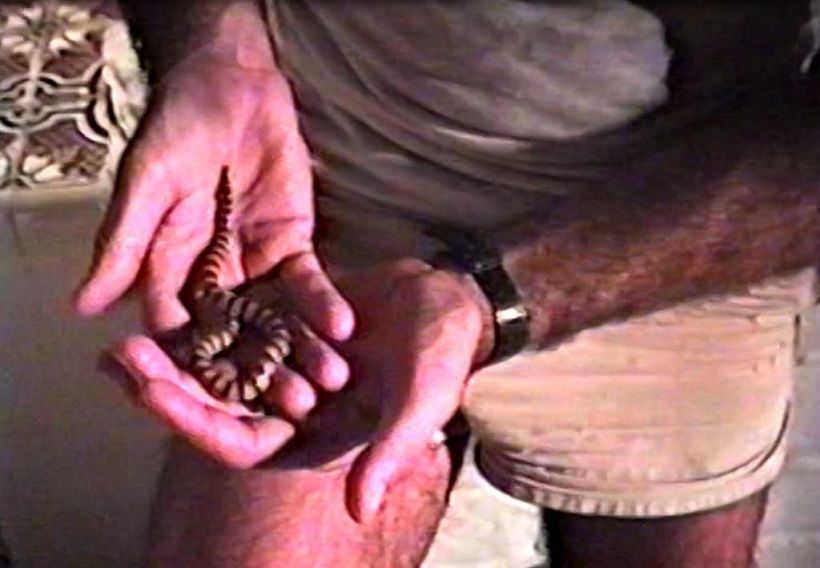
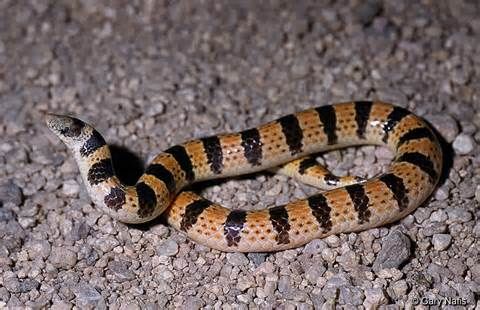
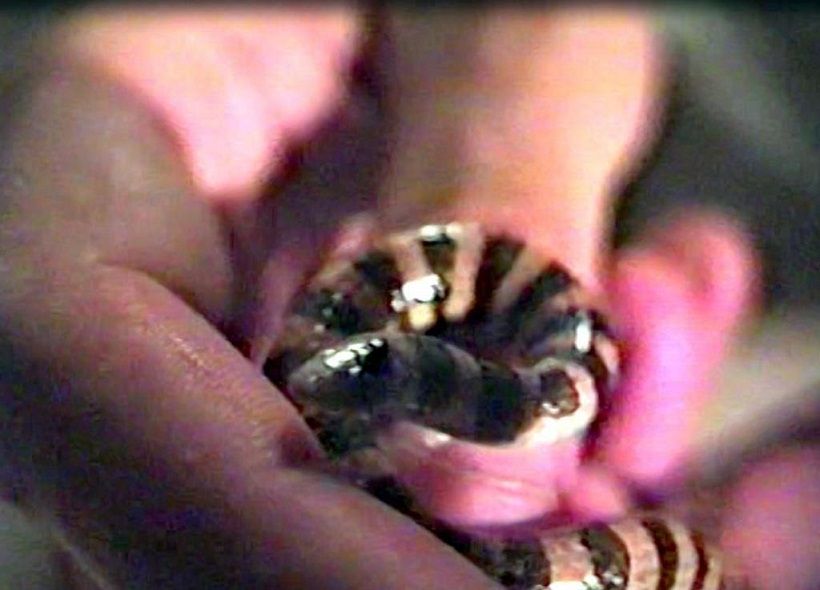
These have very small teeth, but nevertheless VERY sharp! With thanks to Shakespeare, we dubbed this one..."Thankless Child"
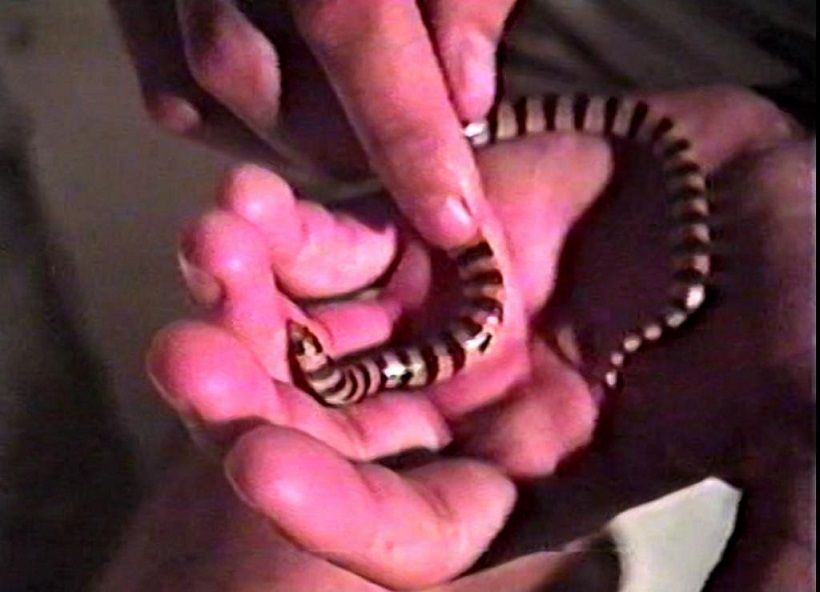
I bet you've heard of Sea Snakes, but have you ever heard of these Sand Snakes before? Ron gives a ton of interesting facts about
these shy little creatures. This was all new to me after having already spent so much time in Baja. It just goes to show that there is always so
much more to learn about this fascinating land.
First, they're small, as you can see, and are also commonly called Banded Sand or Night Snakes. The species name is Chilomeniscus cinctus, which I'll
have to write down to remember.
And don't worry, this snake is non-venemous.
Their color is yellow/orange with 24-28 brown crossbands to tail. Has a white underside with a divided anal plate. Mostly nocturnal, which is why we
seldom see them. During the heat of the day, it is usually submerged beneath the surface, emerging at night to hunt for insects, small scorpions,
c-ckroaches, centipedes and other soft bodied critters of the like. Its spadelike snout helps it 'swim' through sand. To spot them, look for it's
tracks or grooves at the edges of bushes which indicate its subsurface activity.
It is found from central and southwestern Arizona south to Baja California Sur and Sonora, Mexico. C.
It's habitat includes fine sandy areas in open desert dominated by creosote bush; coarse sandy areas in rocky upland washes and arroyos with paloverde
and saguaro.
These are the young and adult banded sand snakes.
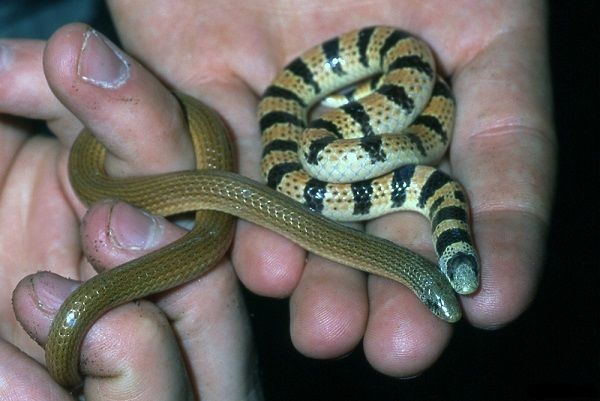
Now comes one we've all had a lot of confrontations with....those ever-present 'scorpions'..and in this case it's the big one:
Desert Hairy Scorpion
Ron cautiously picks up one by it's business end..the stinger. Like all of that night's captures, he kept them in a state of stupor in the cooler.
Becoming very sluggish with the cold, it made them so much easier to handle safely. Like my Pacifico, I prefer a cold scorpion ...or snake.
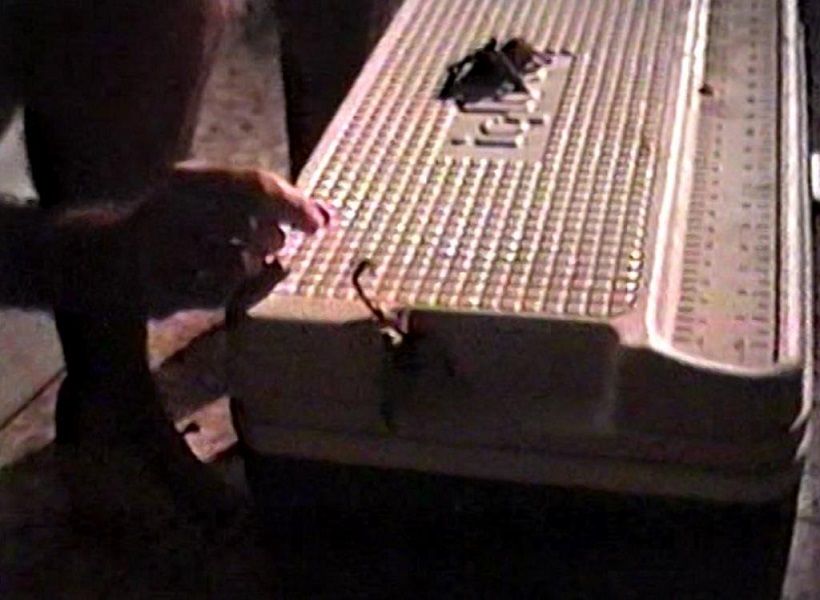
This one is warming up...and AWAY he goes!

We are told some interesting Scorpion Facts.
The most dangerous scorpion is the "Deathstalker" which is prevalent in North Africa and the Middle East. (I made a mental note to not tent camp
there anytime soon.)
Scorpions glow when exposed to an unltraviolet light, like a blacklight, due to flourescent chemicals in the cuticle.
During courtship the scorpions grasp the pedipalps (pincers) and perform a dance called the "promenade a deux."
*Hey Ron, Copilot and I know that dance from the other night at the Serinadad. 

As we know from experience, scorpions don't bite, they "sting."
There are more than 1,500 species of scorpions worldwide.
California and Arizona have the greatest diversity of scorpions with about 60 species.
We learned some valuable regional information about scorpions.
Three Most Common Scorpions Found in the Southwest
1. Desert Hairy Scorpion
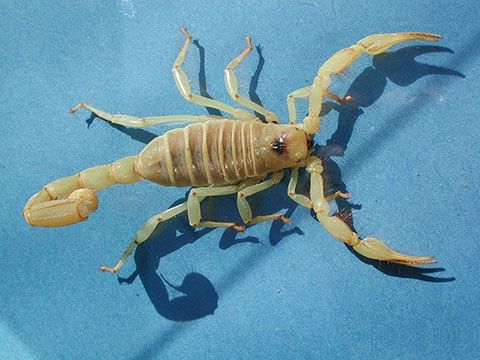
Range: Southern California, Arizona
5-7" in length
Venomous, but not very potent. An allergic reaction to a bite could be very dangerous.
2. Bark Scorpion
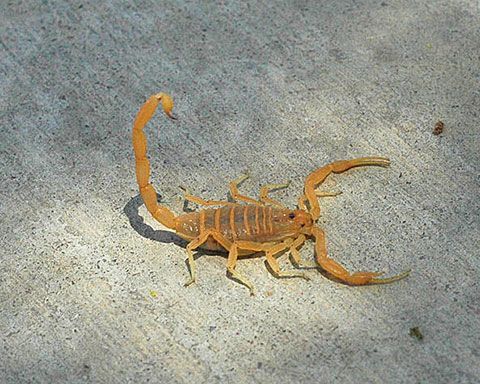
Range: Arizona, Southeastern California, Southwestern New Mexico, Mexico (Baja California and Sonora)
Venomous and dangerous to people. The bark scorpion is the most venomous scorpion in North America.
Light brown in color
Up to 3" in length
3. Stripe-tailed Scorpion
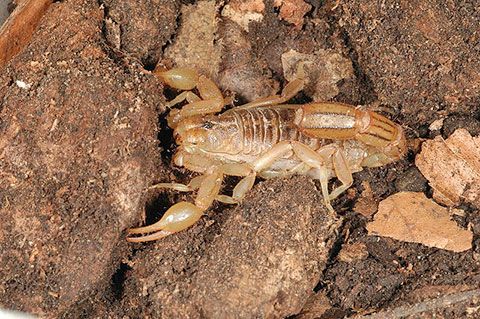
Range: Southern California, Arizona
Venomous, but not considered dangerous.
2.5" in length
Scorpion Collage Ron handles the hairy scorpion, which is still thankfully in a state of stupor from the cold interior of the ice
cooler.
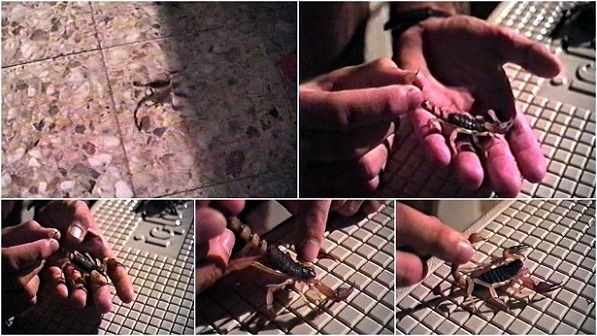
Ron uses a pencil to show a drop of whitish venom on the scorpion's stinger.
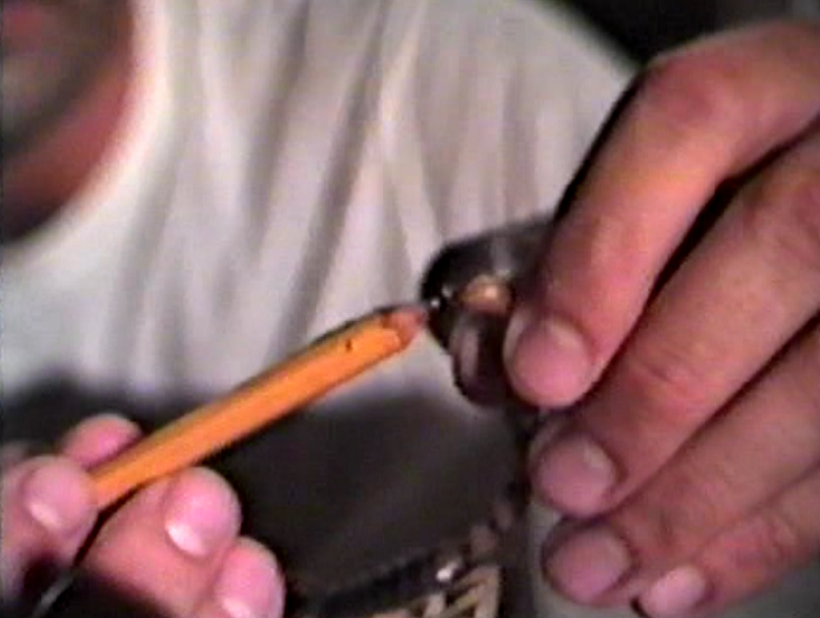
And last speciman of the evening is this handsome fellow, the..
Tarantula
Some facts about the many tarantulas.
There are about 850 species of tarantulas worldwide. Their range includes Africa and Madagascar, parts of the Middle East, southern Europe, southern
Asia, the Indo-Pacific region, Australia, northern New Zealand, some of the Micronesian Islands, all of Central and South America, parts of the
Caribbean, and the United States north to central California and east to the Mississippi River. More than four dozen species populate the U. S. range
Typically, tarantulas live in solitude in desert basins, mountain foothills and forested slopes. They occupy various kinds of nests, with many species
taking up residence in burrows or crevices, which may be sequestered in the ground, along cliff faces, among rocks, under tree bark, or between tree
roots.
Some line their burrows with silk. Some surround the entrance with a silken "welcoming mat," which vibrates like guitar strings and sends signals to
the spider cloistered there, if potential prey should touch the strands. A tarantula will attack literally anything that it can subdue: beetles,
grasshoppers, locusts, other spiders, small lizards and mice. Tarantulas kill by injecting venom through their fangs into their prey.
During mating season, which varies from spring through fall, depending on the species and conditions, the males leave their burrows, sometimes en
masse, to seek willing females. A male, encountering the silk surrounding the entrance to a female's burrow, calls and dances amorously. He may be
rejected or embraced. In either event, he may get eaten up, becoming a readily available source of protein to fuel development of the next generation.
Perhaps this may remind you of a past mate or dating relationship...?
Several weeks after mating, the female produces an egg sac, and six or seven weeks later, hundreds of tiny spiderlings hatch to begin the cycle anew.
After a few weeks, the young disperse to take up their lives. As tarantulas mature, they molt several times, each time shedding their old exoskeleton
for a new one. The males may live for several years, the females, for several decades.
Here are som curious facts about these guys...
Tarantulas are harmless to humans and can be trained as pets.
The tarantula catches its prey by pursuit.
There are more than 800 species of tarantulas.
Some tarantulas have vibrant colors, for instance, the Brazilian white knee tarantula, which has black and white stripes; the Mexican red knee
tarantula, which has a black abdomen and orange and black leg bands; and the Greenbottle blue tarantula, which has a bright orange abdomen and
metallic blue legs.
The name tarantula apparently originated in the 14th century, in the Italian city of Taranto, where people felt compelled to dance the wildly erotic
Tarantella if bitten by a spider.
(Which reminds me once again of a dance...and when I danced that very style with Co-pilot) at Humphrey's in San Diego. The only difference
being that she is from Milan, not Taranto.)
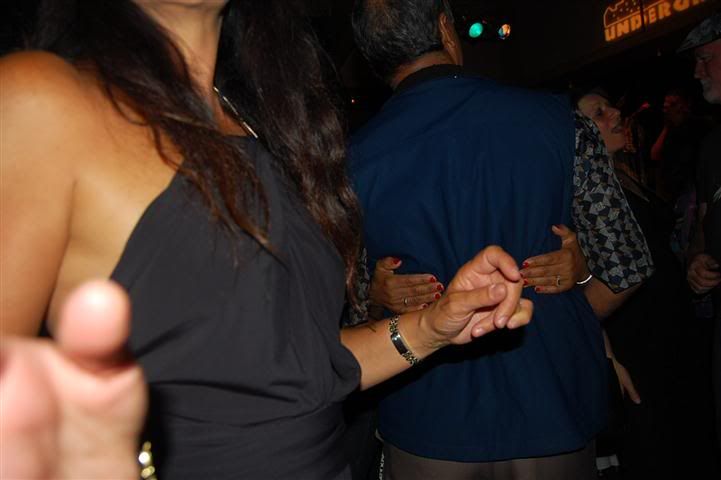
Tarantulas can get quite huge. One Venezuelan species has a leg span of some 11 inches. My great aunt Vera would say as she stomped
it..."Uff Da!"
Most American tarantulas have barbed and mildly venomous urticating hairs on their abdomens, and they use their legs to cast the hairs into the faces
of threatening animals, inflicting irritation of soft tissues and eyes.
Some species have on their feet tiny spinnerets that produce sticky silk patches, helping the spider gain a foothold for climbing on slick surfaces
such as window glass.
Some species produce a buzzing sound, like cloth ripping, by rubbing appendages together. A tarantula's fangs move up and down; all other spider's
fangs move horizontally.
In this collage, Ron shows us various parts of the tarantulas body. In the bottom left photo you can clearly see one of it's fangs on the pencil.
The fangs are needle sharp and of a very hard material, harder than a humans dentene, thus the bite will be quite painful.
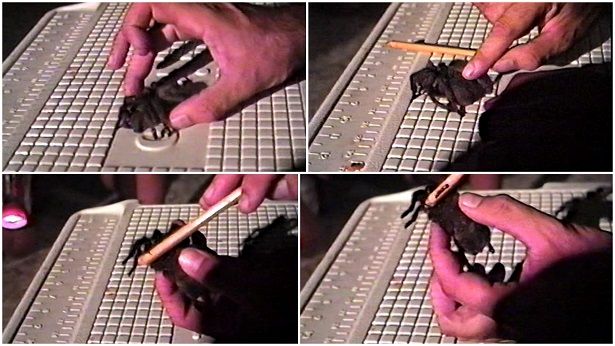
On the move across the floor..when warmed up, these guys can move very fast. Ever seen one high-stepping it across the highway on a hot summer's
night?

A good comparison shown on my size 12 tennis shoe. (I learned early on to always check my shoes before inserting the foot!)
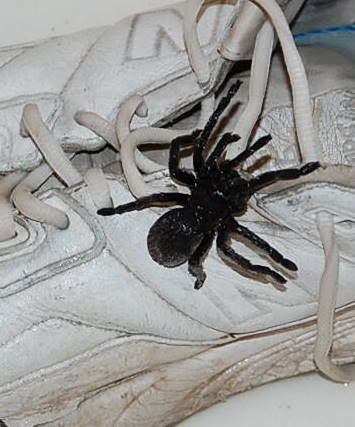
And so that was the end of a great discussion on one very hot evening near my patio fridge...about some creatures of Baja. Ron assures me he has put
all his show-n-tell subjects back into the cooler.
Now I'm off to buy an UV light for a thorough house-check. 
[Edited on 2-4-2015 by Pompano]
I do what the voices in my tackle box tell me.
|
|
|
Cisco
Ultra Nomad
    
Posts: 4196
Registered: 12-30-2010
Member Is Offline
|
|
"A few years ago a gentleman came up to me when I was mounting wasps at a picnic table in a Missouri state park. 'What is the purpose of a wasp?' he
asked. Had I been a lepidopterist, he doubtless would have asked the purpose of a butterfly, though I'm not sure what he would have asked had I been
an anthropologist."
-Howard Ensign Evans
[Edited on 2-3-2015 by Cisco]
|
|
|
Pompano
Elite Nomad
     
Posts: 8194
Registered: 11-14-2004
Location: Bay of Conception and Up North
Member Is Offline
Mood: Optimistic
|
|
Cisco, on a trip to Monterey and the Museum of Natural History Co-pilot did just that. Asked an anthropologist about a certain man's chances in
evolution. He seemed optimistic enough to me....

I do what the voices in my tackle box tell me.
|
|
|
Cisco
Ultra Nomad
    
Posts: 4196
Registered: 12-30-2010
Member Is Offline
|
|
Quote: Originally posted by Pompano  | Cisco, on a trip to Monterey and the Museum of Natural History Co-pilot did just that. Asked an anthropologist about a certain man's chances in
evolution. He seemed optimistic enough to me....
 |
How wonderful.
The great photo of display makes it look like she was well informed also, and by an enthusiastic presenter.
Thanks Amigo
|
|
|
David K
Honored Nomad
        
Posts: 64493
Registered: 8-30-2002
Location: San Diego County
Member Is Offline
Mood: Have Baja Fever
|
|
Thank you Roger!
|
|
|
woody with a view
PITA Nomad
      
Posts: 15937
Registered: 11-8-2004
Location: Looking at the Coronado Islands
Member Is Offline
Mood: Everchangin'
|
|
the best advice? don't get bit/stung!
|
|
|
Whale-ista
Super Nomad
   
Posts: 2009
Registered: 2-18-2013
Location: San Diego
Member Is Offline
Mood: Sunny with chance of whales
|
|
What an educational evening! I wonder how many of these critters are still around, given changes in their homeland over the last 30 years.
Reminds me of an old question I've had: what's the average life expectancy of herpetologists and other researchers who gather live specimens this way?
In 1991 I visited a field research station in Corcovado National Park in Costa Rica. I followed graduate biology dept. students from Univ. of Texas at
Austin, who would take night hikes and set nets to catch birds, or look for various rainforest critters on the ground, in the trees, under rocks etc.
They would quickly turn over a log/rock/leaf and grab- didn't matter what was under there, they just grabbed before it/they ran away.
Ack!
Given the presence of fer de lance snakes (very venomous) and other critters that bite, scratch, etc... well, seemed pretty dangerous work to me!
\"Probably the airplanes will bring week-enders from Los Angeles before long, and the beautiful poor bedraggled old town will bloom with a
Floridian ugliness.\" (John Steinbeck, 1940, discussing the future of La Paz, BCS, Mexico)
|
|
|
bajabuddha
Banned
Posts: 4024
Registered: 4-12-2013
Location: Baja New Mexico
Member Is Offline
Mood: Always cranky unless medicated
|
|
About 15 years ago I had the honor of running a thee-day river trip down the San Juan River from Bluff to Mexican Hat, Utah, solo boat, and my two
passengers were the Professor of Entomology from UC Berkley and his partner. I was able to share my lay knowledge of the archaeology and geology of
the canyon, and he constantly was turning over every rock, piece of drift, log, whatever, and pointing out the 'smaller world' around us as well.
He would proudly brag to be a Doctor that could state with 100% certainty that not one of his patients ever survived. Quite the character. On one
side hike in a steep limestone canyon we found a small water seep and marsh area, and he said it would be a wonderful place to find a desert Orchid.
"Orchids?? In Utah desert?" I queried. He burrowed into a heavy grass tuft, and hiding timidly behind in the shade and in boggy soil, sure enough
was one with just a bud showing, not yet opened (still mid-April). He told me to come back in a couple of weeks to see the flower, they are kind of
rare. I asked him if they were an aromatic bloom, and very enthusiastically he said "Oh, yes !! They're pollenated by houseflies, so they smell JUST
LIKE ROTTING FLESH !! ", said with a big grin. I did the hike a few weeks later, and sure enough, desert orchid. One memorable trip.
I don't have a BUCKET LIST, but I do have a F***- IT LIST a mile long!
86 - 45*
|
|
|
durrelllrobert
Elite Nomad
     
Posts: 7393
Registered: 11-22-2007
Location: Punta Banda BC
Member Is Offline
Mood: thriving in Baja
|
|
I was on my home from work at China Lake and I stopped to pick up an escaped pot bellied pig running down the centerline of the highway. Put it in my
garage for safe keeping while I advertised found pig in the local lost and found column. Anyway I was awakened during the night by a large commotion
and squealing coming from the garage. Went into the garage barefooted and sure enough got stung on the ankle by a large scorpion. Sting swelled up the
size of a golf ball and hurt like hell. That was it and 2 days later everything back to normal for me and the pig but not so much for the deceased
scorpion.
Bob Durrell
|
|
|
Osprey
Ultra Nomad
    
Posts: 3694
Registered: 5-23-2004
Location: Baja Ca. Sur
Member Is Offline
|
|
A recent Mexican news article about the big robbery of the 7 million pesos in tax money in Cabo had another small piece about the serpentarium in La
Paz being robbed. Didn't say "of what" so I hope it was just the cash. Dr. Abe Blank of Aguas Caliente founded that place and it would be a shame to
lose the reptiles to thieves.
Many many years ago I captured a small sand snake at the Las Arenas lighthouse near Bay of Dreams (then Bay of the Dead) and when I got home I looked
it up. The name intrigued me: it is known as the Las Arenas Lighthouse Sand Snake -- only place to find them. Whew.
|
|
|
Skipjack Joe
Elite Nomad
     
Posts: 8084
Registered: 7-12-2004
Location: Bahia Asuncion
Member Is Offline
|
|
"You suck out de poison"
|
|
|
Floatflyer
Nomad
 
Posts: 311
Registered: 2-15-2009
Location: Whidbey Island, WA
Member Is Offline
Mood: Wet & Cold
|
|
Pompano:Thanks for starting this thread! I now have to creep around our place looking for disaster at every step. This bad boy almost got me a few
years ago as I was walking through the doorway from the kitchen to the breezeway and only saw him with one more step as I ducked to keep from hitting
my had on the door jamb! No doubt I would have been bit!!

|
|
|
bajalearner
Senior Nomad
  
Posts: 670
Registered: 8-24-2010
Location: Tijuana
Member Is Offline
Mood: in search of more
|
|
Quote: Originally posted by durrelllrobert  | | I was on my home from work at China Lake and I stopped to pick up an escaped pot bellied pig running down the centerline of the highway. Put it in my
garage for safe keeping while I advertised found pig in the local lost and found column. Anyway I was awakened during the night by a large commotion
and squealing coming from the garage. Went into the garage barefooted and sure enough got stung on the ankle by a large scorpion. Sting swelled up the
size of a golf ball and hurt like hell. That was it and 2 days later everything back to normal for me and the pig but not so much for the deceased
scorpion. |
Moral of that story is to put the protection on before responding to those pot bellied pigs off the street.
|
|
|
Pompano
Elite Nomad
     
Posts: 8194
Registered: 11-14-2004
Location: Bay of Conception and Up North
Member Is Offline
Mood: Optimistic
|
|
Quote: Originally posted by Floatflyer  | Pompano:Thanks for starting this thread! I now have to creep around our place looking for disaster at every step. This bad boy almost got me a few
years ago as I was walking through the doorway from the kitchen to the breezeway and only saw him with one more step as I ducked to keep from hitting
my had on the door jamb! No doubt I would have been bit!!
 |
Floatflyer: Glad you had to look down and avoid being hit by that rattler, amigo. I think a lot of us have had close calls with serpents in Baja.
Your event reminds me of a time when a rattlesnake had crawled in through an open patio door and then into the pantry of a friend's house at Coyote
Bay. The elderly homeowner was alone and shakily went after the snake with a broomstick. The snake was getting the upper hand until her two Siamese
cats came to attack the snake, giving her the opportunity to club the snake...repeatedly.
Quite a daring rescue by this sibling pair who are shown taking it easy on my lap at their casa after all the ruckus was over. I gained a lot of
respect for cats that day. (I've always respected ladies with broomsticks..)
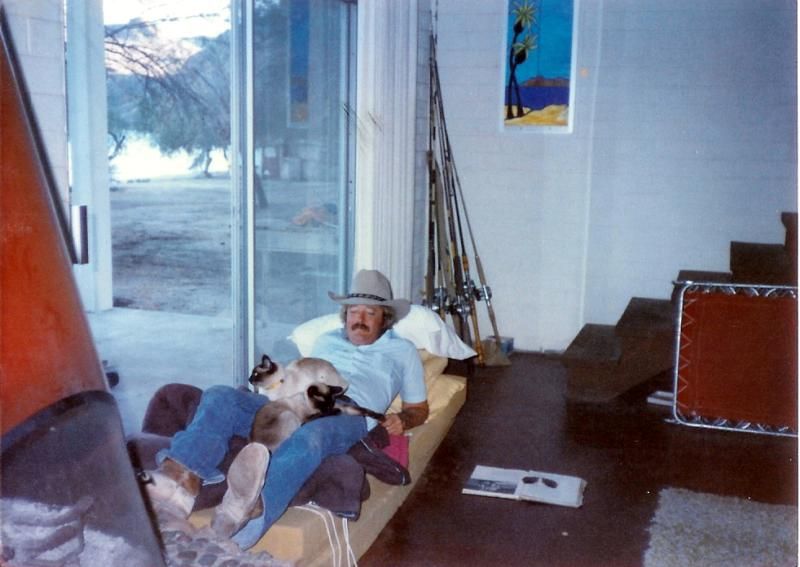
I do what the voices in my tackle box tell me.
|
|
|
David K
Honored Nomad
        
Posts: 64493
Registered: 8-30-2002
Location: San Diego County
Member Is Offline
Mood: Have Baja Fever
|
|
Floatflyer, good job with the photo posting! Have you read Erle Stanley Gardner's 1961 book 'Hovering Over Baja'?
He goes into great detail about the Red Diamondback Rattler's most deadly bite!
|
|
|
Pacifico
Super Nomad
   
Posts: 1299
Registered: 5-26-2008
Member Is Offline
|
|
Quote: Originally posted by David K  | Floatflyer, good job with the photo posting! Have you read Erle Stanley Gardner's 1961 book 'Hovering Over Baja'?
He goes into great detail about the Red Diamondback Rattler's most deadly bite! |
The red diamond rattlesnake actually has one of the least potent venoms in the rattlesnake world. Far from the most deadly... They are also quite
mellow in disposition. Still, wouldn't want to get bite by one though!
"Plan your life as if you are going to live forever. Live your life as if you are going to die tomorrow." - Carlos Fiesta
|
|
|
juanroberts
Junior Nomad

Posts: 62
Registered: 9-27-2005
Location: Piedmont, CA
Member Is Offline
Mood: Baja Born
|
|
Agreed. The author did not do his research and based his notes on local lore, or as they say, did not let the facts get in the way of a good story.
Although the book is fact based, this could serve as an embellishment to a big mystery related to the missing miner’s pick (page 115). It was very
Perry Masonesque.
Then again, the remoteness of the location would make such an event quite deadly even if the snake was not the worst. Ok, enough with the hijack of
this thread.
|
|
|
AKgringo
Elite Nomad
     
Posts: 5819
Registered: 9-20-2014
Location: Anchorage, AK (no mas!)
Member Is Offline
Mood: Retireded
|
|
Is someone messing with the space/time continuum?
For a moment, I thought Pompano was back online!
If you are not living on the edge, you are taking up too much space!
"Could do better if he tried!" Report card comments from most of my grade school teachers. Sadly, still true!
|
|
|
David K
Honored Nomad
        
Posts: 64493
Registered: 8-30-2002
Location: San Diego County
Member Is Offline
Mood: Have Baja Fever
|
|
juanroberts replied to a 5-year-old thread... It was fun the way Erle Stanley Gardner made up great stories with an occasional fact or two!
|
|
|
LancairDriver
Super Nomad
   
Posts: 1587
Registered: 2-22-2008
Location: On the Road
Member Is Offline
|
|
I was hoping he was back when I saw “Pompano” come up. His usual entertaining writing style is missed. Typical interesting story about the snakes.
I always wished he had written a book on his Baja adventures.
|
|
|
| Pages:
1
2 |
|

